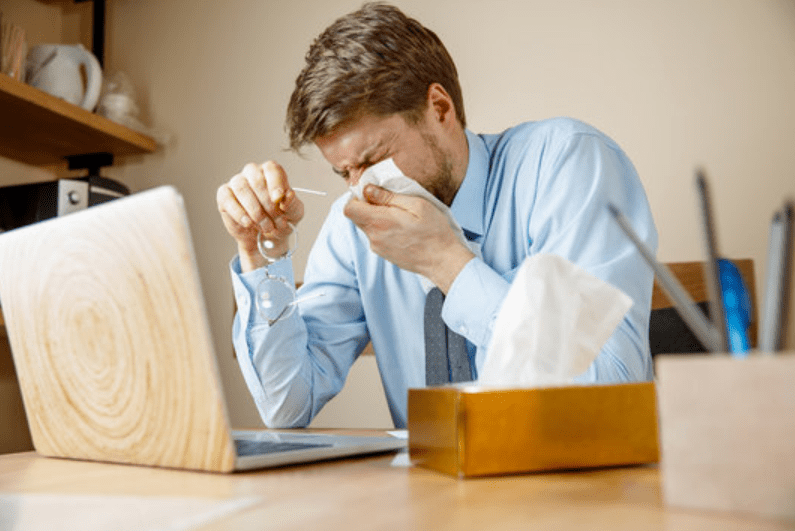Explore the connection between air conditioning and allergies, discover common allergens associated with air-conditioned environments, and learn preventive measures to minimize allergic reactions
Air conditioning is a modern luxury essential to our daily lives. However, there is a growing concern that using air conditioners may trigger allergies.
Let’s explore the potential causes of allergic reactions related to air conditioning and check some practical advice on preventing and managing these allergies.
The Connection Between Air Conditioning and Allergies
Air conditioners work by cooling and dehumidifying the air, creating an environment that contributes to the growth of allergens such as mold, mildew, and dust mites.
Additionally, air conditioning units can circulate and trap allergens in the air, which may lead to an increased risk of allergic reactions for some individuals.
How Air Conditioners Can Harbor and Spread Allergens
There are several ways in which air conditioners can contribute to the spread of allergens:
- Improper Filtration: Air conditioning systems use filters to trap dust, pollen, and other airborne particles. However, if the filters are not properly maintained or replaced, they can become clogged and ineffective, allowing allergens to circulate freely.
- Mold and Mildew Growth: The cool and damp conditions created by air conditioning systems can promote the growth of mold and mildew, which are common allergens.
- Poor Ventilation: Poorly ventilated spaces can trap allergens and prevent them from being properly diluted, increasing the concentration of allergens in the air.
Common Allergens Associated with Air Conditioning
Some of the most common allergens that can be found in air-conditioned environments include:
- Dust Mites: These microscopic creatures thrive in warm and humid conditions, and their droppings can cause allergic reactions.
- Mold and Mildew: The dampness created by air conditioning can promote the growth of mold and mildew, which release spores into the air that can trigger allergies.
- Pollen: Outdoor pollen can enter homes and buildings through open windows and doors, or be carried in on clothing and shoes. Once inside, pollen can become trapped and circulated by air conditioning systems.
- Pet Dander: Pet dander can become airborne and be circulated by air conditioning systems, causing allergic reactions in sensitive individuals.
Causes of Air Conditioning Sickness Symptoms
Air conditioning sickness, also known as “sick building syndrome,” can result from various factors related to air conditioning systems and indoor environments. The following are common causes of air conditioning sickness symptoms:
1. Poor Indoor Air Quality
Contaminants such as dust, mold spores, pollen, and volatile organic compounds (VOCs) can accumulate in indoor spaces, leading to poor air quality. Prolonged exposure to these contaminants can cause symptoms such as headaches, fatigue, and respiratory issues.
2. Inadequate Ventilation
Insufficient ventilation can cause a buildup of stale air and pollutants, leading to discomfort and illness. Proper ventilation is essential for maintaining good indoor air quality and preventing air conditioning sickness symptoms.
3. Low Humidity Levels
Air conditioning systems can reduce indoor humidity levels, causing dry air. Low humidity can lead to dry skin, irritated eyes, and respiratory issues such as sore throats and sinus congestion.
4. Temperature Fluctuations
Rapid temperature changes, such as transitioning from a hot outdoor environment to a cold, air-conditioned space, can cause physical discomfort and trigger symptoms like headaches, dizziness, and fatigue.
5. Bacterial and Fungal Contamination
Air conditioning systems can harbor bacteria and fungi, which can be circulated throughout indoor spaces. Exposure to these microorganisms can lead to respiratory issues, allergic reactions, and other health problems.
6. Chemical Emissions from Building Materials
Some building materials, furnishings, and cleaning products emit VOCs, which can cause irritation and discomfort when inhaled. Air conditioning systems can circulate these chemicals, exacerbating air conditioning sickness symptoms.
Tips for Preventing Air Conditioning Sickness Symptoms
To minimize the risk of air conditioning sickness, consider implementing the following strategies:
- Maintain Your Air Conditioning System: Regularly clean and replace filters, and schedule routine maintenance to ensure optimal performance and minimize the buildup of pollutants.
- Improve Ventilation: Ensure your space is adequately ventilated by opening windows and doors, using exhaust fans, or installing an energy recovery ventilator (ERV).
- Control Humidity: A humidifier maintains indoor humidity levels between 30% and 50%, promoting a more comfortable environment.
- Choose Low-VOC Products: Opt for building materials, furnishings, and cleaning products with low VOC emissions to reduce the presence of harmful chemicals in your indoor environment.
- Clean Regularly: Regular cleaning can help remove contaminants from surfaces and prevent them from becoming airborne.
Addressing the causes of air conditioning sickness symptoms and taking preventive measures can create a healthier and more comfortable indoor environment.
Addressing Allergens in Your HVAC System
The heating, ventilation, and air conditioning (HVAC) system in your home or workplace can also contribute to the presence of allergens. To minimize the impact of allergens on your indoor environment, consider the following measures:
- Duct Cleaning: Over time, dust, mold, and other allergens can accumulate in your HVAC system’s ductwork. Schedule professional duct cleaning to remove these contaminants and improve indoor air quality.
- UV Light Installation: Installing ultraviolet (UV) lights in your HVAC system can help reduce the growth of mold and bacteria by disrupting their DNA, preventing them from reproducing and spreading.
- Upgrade to a High-Efficiency Filter: Consider using high-efficiency particulate air (HEPA) filters or other high-quality filters in your HVAC system to better trap allergens and prevent them from circulating throughout your space.
Managing Allergy Symptoms
Despite your best efforts to prevent allergens from affecting your indoor environment, you may still experience allergy symptoms. Here are some strategies to help manage and alleviate these symptoms:
- Over-the-Counter Medications: Antihistamines, decongestants, and corticosteroid nasal sprays can help relieve allergy symptoms. Consult with a healthcare professional before starting any new medications.
- Immunotherapy: Immunotherapy (allergy shots) may be an option for severe or persistent allergies. This treatment involves receiving small doses of allergens over time, which can help your body build up a tolerance and reduce allergic reactions.
- Avoidance: Limit your exposure to allergens whenever possible, particularly during peak pollen seasons or when mold and mildew are prevalent.
- Stay Hydrated: Drinking plenty of water can help alleviate allergy symptoms by thinning mucus and reducing congestion.
- Create an Allergy-Friendly Sleep Environment: Encase your mattress, pillows, and box spring in allergen-proof covers, and wash your bedding regularly in hot water to reduce exposure to allergens while you sleep.
Educating Yourself and Others About Allergies
Knowledge is power, and being well-informed about allergies and their triggers can help you and those around you better understand and manage allergy symptoms. Consider the following:
- Stay Informed: Keep up-to-date on the latest allergy research, treatments, and recommendations by following reputable sources such as medical journals, allergy organizations, and healthcare professionals.
- Share Your Knowledge: Educate your friends, family, and colleagues about allergies and the importance of taking preventive measures to maintain a healthy indoor environment.
- Advocate for Allergy Awareness: Promote allergy awareness in your community and workplace by organizing events, sharing resources, and encouraging others to adopt allergy-friendly practices.
By taking these preventive measures and staying informed about allergies, you can create a healthier indoor environment and minimize the risk of allergic reactions related to air conditioning.
Final Word
Air conditioning plays a significant role in our everyday comfort, especially during hot summer months or in regions with warmer climates. However, it’s essential to know the potential connection between air conditioning systems and allergies.
Factors such as poor indoor air quality, inadequate ventilation, airborne allergens, and bacterial or fungal growth within the AC unit can trigger allergic reactions and other health issues.
Regular maintenance and cleaning of air filters, air ducts, and the entire air conditioning equipment, as well as investing in air purifiers and HEPA filters, can help reduce the presence of airborne allergens, bacteria, and viruses.
By taking these preventive measures, you can maintain a healthy indoor environment, minimize allergy symptoms, and enjoy the cool air your air conditioning system provides during allergy season and year-round.
Conclusion
In conclusion, air conditioner allergy problems can be attributed to several airborne allergens, indoor air pollution, and contaminants that may breed inside the air conditioning unit. Proper filters, regular maintenance, and outstanding customer service are crucial for keeping your living space free of allergens and ensuring a comfortable environment.
Stay vigilant during allergy season and ensure your cooling system operates efficiently by keeping your air filters, AC ducts, and air conditioning equipment clean. Implementing air purifiers with HEPA filters can also help mitigate allergy symptoms and reduce indoor air pollution.
Addressing these factors can create a healthier living space and minimize the chances of experiencing difficulty breathing, sneezing, coughing, or other allergy-related symptoms caused by your air conditioning unit.








